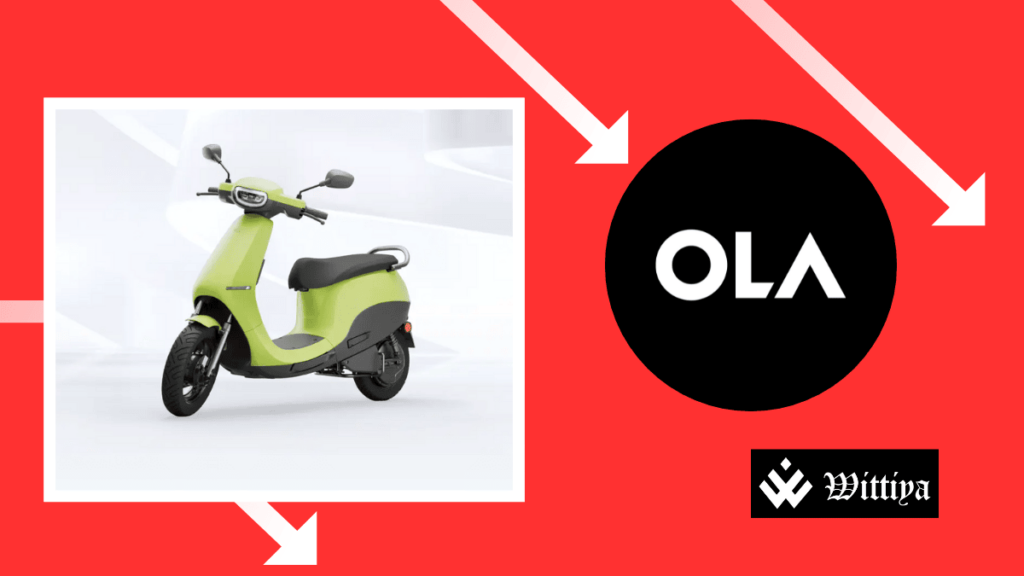Ola Electric, once the dominant force in India’s electric two-wheeler market, now faces an uncertain future marked by mounting financial losses, mass layoffs, and customer dissatisfaction. Founded in 2017 by Bhavish Aggarwal, the company’s aggressive expansion and heavy reliance on imported Chinese components have led to operational and service challenges. With leadership exits and declining market share amid fierce competition from legacy players like TVS and Bajaj, Ola Electric’s journey from disruptive innovator to a cautionary tale in India’s EV landscape is unfolding rapidly.
Ola Electric, founded in 2017 by Bhavish Aggarwal, rapidly emerged as a prominent player in India’s electric vehicle (EV) sector, particularly in the two-wheeler segment. Despite its initial success, the company has recently faced a series of challenges impacting its operations, market position, and public perception.
Business Model: Assembly-Driven Operations with Chinese Imports
Ola Electric’s operational framework is characterized by a vertically integrated approach encompassing research and development, manufacturing, supply chain management, sales, service, and charging infrastructure. A significant aspect of this model involves importing key components from international suppliers, particularly from China, and assembling the final products in India.
In the fiscal year 2023-24 (FY24), Ola Electric’s reliance on Chinese imports became more pronounced. The company’s Red Herring Prospectus revealed that imports from China accounted for 37% of its total material costs, a substantial increase from 19% in the previous financial year. This surge underscores the company’s dependence on Chinese suppliers for essential raw materials, including lithium-ion cells, magnets, amplifiers, and electronic integrated circuits. In monetary terms, out of the total material costs of approximately ₹4,390 crore in FY24, imports from China constituted around ₹1,624 crore.
Despite efforts to diversify its supply chain, the proportion of imports from China has increased, even as the overall import percentage decreased from 37% to 29%. This indicates a growing dependence on Chinese components, which poses potential risks related to supply chain disruptions and geopolitical tensions.
To mitigate these challenges, Ola Electric has initiated steps to enhance localization. The company has identified and engaged with 201 suppliers across countries such as South Korea, Japan, Europe, the USA, and India to explore supply capabilities and localization potential. Discussions with 98 suppliers have been completed, and 76 samples have been procured for validation at the company’s Battery Innovation Center.
Organizational Overview and Key Events
Since its inception in 2017, Ola Electric has achieved several significant milestones that have shaped its trajectory in the EV industry.
- August 15, 2021: The company commenced production of its first electric scooter at the Ola Future Factory in Krishnagiri, Tamil Nadu. This state-of-the-art facility spans 500 acres and is notable for its automation, including the deployment of robots in welding, painting, battery assembly, and motor assembly lines.
- August 15, 2024: Ola Electric expanded its product lineup by launching the ‘Roadster’ series of electric motorcycles. This move marked the company’s foray into the electric motorcycle segment, aiming to cater to a broader spectrum of consumers and compete with established players in the market.
- August 9, 2024: The company made its debut on the stock market with an Initial Public Offering (IPO). The IPO was met with enthusiasm, and the shares experienced a significant surge, doubling in value within a few trading sessions.
Research and Innovation: Balancing Ambitions with Execution
Ola Electric has consistently emphasized its commitment to research and development (R&D) to drive innovation in the EV sector. The company’s official communications highlight a focus on building high-quality and accessible EV products through in-house design, engineering, and manufacturing capabilities.
A cornerstone of this commitment is the establishment of the Battery Innovation Center (BIC) in Bangalore, announced in July 2022. With an investment of $500 million, the BIC aims to develop advanced cell technologies and position itself as one of the world’s largest and most advanced cell R&D facilities. The center is expected to recruit top industry talent, including 500 PhDs and engineers, to spearhead innovations in battery technology.
In October 2024, Ola Electric introduced the Ola Digital Twin platform, developed in collaboration with NVIDIA Omniverse. This platform integrates advanced simulation tools and artificial intelligence to optimize manufacturing processes and accelerate product development cycles. The initiative underscores the company’s efforts to harness cutting-edge technologies to enhance operational efficiency and product quality.
Despite these ambitious initiatives, questions have arisen regarding the tangible outcomes of Ola Electric’s R&D investments. While the company has announced several innovative projects, the translation of these initiatives into market-ready products and solutions has faced challenges. For instance, the company’s plan to launch electric cars was reportedly suspended in July 2024 to refocus on scooters and motorcycles, indicating potential hurdles in scaling R&D efforts to commercial viability.
Escalating Financial Losses
In the December quarter of the fiscal year 2024 (Q3 FY24), Ola Electric reported a net loss of ₹564 crore (approximately $64 million), a substantial 50% increase from the ₹376 crore loss recorded in the same period the previous year. This widening deficit underscores the company’s ongoing struggle to achieve profitability.
Several factors have contributed to these mounting losses:
- Aggressive Discounting: To counter rising competition, Ola Electric implemented significant discounts on its electric scooters. While this strategy aimed to boost sales volumes, it adversely affected revenue, which declined by 19.4% to ₹1,045 crore during the quarter.
- Service Quality Improvements: The company incurred a one-time expense of ₹110 crore to enhance service quality in response to regulatory scrutiny and customer feedback. This investment, though necessary for long-term customer satisfaction, added to the short-term financial burden.
Service Complaints and Product Quality Concerns
Ola Electric’s rapid expansion in the electric two-wheeler market has been accompanied by a surge in customer complaints and concerns regarding product quality. These issues have raised questions about the company’s commitment to after-sales service and the reliability of its vehicles.
Reports indicate that Ola Electric receives approximately 80,000 complaints each month, with daily peaks ranging between 6,000 and 7,000. These complaints encompass a variety of issues, including delayed deliveries, subpar after-sales service, and product malfunctions. In response to the growing number of grievances, the Central Consumer Protection
Mass Layoffs: A Cost-Cutting Strategy or a Sign of Deeper Problems?
In March 2025, Ola Electric laid off over 1,000 employees, nearly one-fourth of its workforce, in what the company called an internal restructuring effort to focus on profitability. This followed an earlier layoff of 500 employees in November 2024, bringing the total workforce reduction to over 1,500 employees within just five months. The affected departments included procurement, fulfillment, customer relations, and charging infrastructure, with most cuts coming from non-manufacturing roles.
Despite being India’s largest electric two-wheeler manufacturer, Ola Electric has struggled with increasing losses, forcing it to implement these drastic cost-cutting measures. The company cited operational efficiencies and restructuring for sustainable growth as the reason for these layoffs. However, industry analysts argue that mismanagement, high burn rates, and unrealistic expansion plans have contributed to this financial distress.
While layoffs are common in growing tech and automotive firms, such large-scale workforce reductions in a short period indicate deeper financial and operational issues. Reports suggest that high attrition rates and an intense work culture have also contributed to employees leaving voluntarily, further affecting productivity.
Top-Level Exodus: A Leadership Crisis
In addition to layoffs, Ola Electric has witnessed an exodus of top executives over the last two years, raising red flags about leadership stability. Several high-ranking officials, including Chief Financial Officer (CFO) Swayam Saurabh, Chief Technology Officer (CTO) Arun Sirdeshmukh, and Chief Marketing Officer (CMO) Varun Dubey, have left the company, many within less than a year of joining.
The departure of key executives indicates instability at the leadership level, making it harder for the company to execute its long-term vision. Reports suggest that aggressive internal policies, unrealistic deadlines, and lack of autonomy contributed to these high-profile exits.
With Ola Electric gearing up for further expansion in the EV space, leadership retention and workforce morale will be critical factors determining the company’s ability to navigate its current crisis and stay ahead in India’s competitive electric two-wheeler market.
Ola’s Declining Market Share Amidst TVS and Bajaj’s
Ola Electric, once the vanguard of India’s e2W market, has witnessed a notable decline in its market share. In November 2024, the company sold 29,191 scooters, capturing 24.5% of the market—a decrease from its 33% share in November 2023 . The downward trajectory continued, culminating in December 2024 when Ola was overtaken by competitors Bajaj Auto and TVS Motor .
Bajaj Auto and TVS Motor have capitalized on Ola’s diminishing foothold. In December 2024, Bajaj Auto emerged as the top e2W seller, surpassing Ola Electric . TVS Motor also made significant strides, with its iQube model holding a 23% market share, closely trailing Bajaj’s Chetak at 25%, while Ola’s share dwindled to 19%.
Writing on the Wall
Ola Electric’s journey, once heralded as the future of India’s EV revolution, now teeters on the edge of uncertainty and decline. The company’s aggressive expansion strategy, coupled with poor execution, rising financial losses, and an overreliance on imported components, has left it in a precarious position. What was once a market leader with over 50% share is now struggling to maintain even a quarter of the market, as legacy players like TVS, Bajaj, and Hero rapidly eat into its dominance with superior products, robust service networks, and proven industry expertise.
For Ola Electric to survive the next phase of India’s EV boom, it must undergo a fundamental transformation—one that prioritizes customer satisfaction, builds long-term financial sustainability, and fosters innovation beyond mere marketing gimmicks. Without immediate and decisive course correction, Ola Electric risks going from being a disruptor to just another cautionary tale in India’s startup ecosystem.



